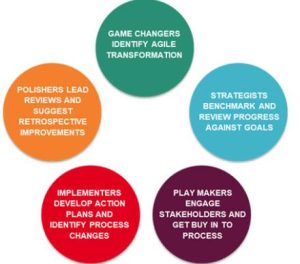How Is Agile Strategy Development Conducted?
Agile strategy development is transforming how organizations plan and execute their strategic initiatives. This methodology focuses on responsiveness, adaptability, and continuous improvement. It allows businesses to navigate the complexities of today’s fast-changing environment effectively. Here’s a closer look at how agile strategy development unfolds, marked by rapid iteration and stakeholder involvement.

Initiate with Collaborative Visioning
The process begins with a collaborative visioning session where stakeholders define clear, strategic goals aligned with the organization’s overarching vision. This step ensures that all team members understand and agree on the desired outcomes. According to a study by McKinsey, organizations that engage stakeholders in goal setting are 3.5 times more likely to outperform their peers in terms of organizational performance.
Set Actionable, Short-term Objectives
Agile strategy development breaks down long-term goals into short-term, actionable objectives. These are often framed as sprints lasting from a few weeks to a couple of months. The shorter timeframe allows teams to remain flexible and adjust their strategies based on real-time feedback and changing market conditions. Research from the Agile Alliance shows that companies using short cycles for planning and review are 50% more likely to achieve their strategic goals quickly and efficiently.
Engage in Continuous Planning and Feedback Loops
Unlike traditional strategy frameworks that often set a plan and revisit it annually, agile strategy involves continuous planning and regular feedback loops. Teams meet frequently—typically every two weeks—to review progress and iterate on the plan as necessary. This dynamic approach helps identify issues early, allowing for timely adjustments. A survey by Forrester found that 40% of firms that adopted continuous planning and feedback improved their strategic agility.
Implement with Cross-Functional Teams
Execution is carried out by cross-functional teams that bring together diverse skills and perspectives. These teams are empowered to make decisions and adapt their approach as needed, enhancing both the speed and quality of execution. Data from Deloitte indicates that organizations with empowered, cross-functional teams see an improvement in project success rates by up to 60%.
Measure Performance Rigorously
Measurement is a critical component of agile strategy development. Each sprint includes specific, measurable objectives, and key performance indicators (KPIs) are used to track progress. This rigorous measurement ensures that the strategy is achieving the desired outcomes and provides a basis for further refinement. According to Harvard Business Review, companies that measure performance systematically are 30% more likely to meet their strategic objectives.
Refine and Scale Successful Initiatives
Upon completing each cycle, the team assesses what worked and what didn’t. Successful strategies are refined and scaled, while less effective elements are discontinued. This step is crucial for ensuring that the strategy remains aligned with the organization’s goals and market needs. Statistics from the Project Management Institute reveal that agile organizations successfully scale their winning initiatives at a rate 27% higher than their non-agile counterparts.
Fostering Agile Strategy Development
In conclusion, agile strategy development is a robust, iterative process that embraces change and seeks to continually adapt and improve. By engaging teams in a cycle of planning, execution, evaluation, and refinement, organizations can not only keep pace with changes in their environment but can also drive meaningful, sustainable growth. This approach is essential for any business aiming to remain competitive in an unpredictable global market.